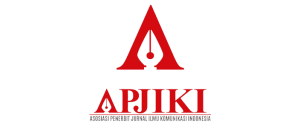Communication Pattern "Omahjiwa" Community Counselor in Helping Counselee Who have Anxiety Disorder
DOI:
https://doi.org/10.30656/lontar.v11i1.6163Keywords:
Anxiety Disorder, Communication Pattern, Councelor, Interpersonal Communication, Mental HealthAbstract
Mental health is an important thing for everyone to have. Because with a healthy mentality, individuals can do their days productively and can also maximize the abilities that exist in themselves. However, since the pandemic came, all activities have stopped and people also need to follow the changes caused by the pandemic. Because of this, people also feel lost and are also worried about what will happen in the future, which eventually leads to excessive worry. At that time the mental health of some people finally felled and along with this, several communities related to mental health issues emerged on social media to help everyone who had mental disorders. One of these communities is OmahJiwa which provides free counseling for everyone who has mental problems, one of which is anxiety disorders. The purpose of this study was to see the pattern of communication and also the effectiveness of interpersonal communication between a counselor and a counselee who has an anxiety disorder. This research uses a post positivist paradigm with a qualitative approach. The concepts used are Communication Patterns and Interpersonal Communication. The results obtained from this study are the OmahJiwa Community Counselors use 4 Communication Patterns (primary, secondary, linear, circular) and use Two-Way Communication Patterns. 5 directions for the effectiveness of Interpersonal Communication that occurs between counselors and counselees, but the most prominent are empathy, support, and positiveness
References
Aini, L. N., & Muti’ah, T. (2022). International Seminar Commemorating The 100 Th Anniversary Of Tamansiswa | Yogyakarta.
Alexander, C., Christianto, J., & Venturini, H. (2022). Penerapan Cyber Counseling dalam Menangani Depresi Remaja pada Masa Pandemi Covid-19. KHARISMATA: Jurnal Teologi Pantekosta, 4(2), 249–262. https://doi.org/10.47167/kharis.v4i2.124
Allen, M. P. R. et al. (2002). Interpersonal Communication Research -- Advances Through Meta-analysis.
Dianovinina, K., & Psikologi, F. (2018a). Depresi pada Remaja: Gejala dan Permasalahannya Depression in Adolescent: Symptoms and the Problems. In Jurnal Psikogenesis (Vol. 6, Issue 1).
Fauziyyah, R., & Citra Awinda, R. (2021). Dampak Pembelajaran Jarak Jauh terhadap Tingkat Stres dan Kecemasan Mahasiswa selama Pandemi COVID-19 (Vol. 1). http://pdskji.org/home.
Fazira, S. H. ; H. A. ; L. F. (2023). Faktor Penyebab Quarter Life Crisis Pada Dewasa Awal (Vol. 5).
Freese, L., & Burke, P. J. (n.d.). Persons, Identities, And Social Interaction (Vol. 11). JAI Press.
Hariko, R. (2017). Landasan Filosofis Keterampilan Komunikasi Konseling. Jurnal Kajian Bimbingan Dan Konseling, 2(2), 41–49. http://journal2.um.ac.id/index.php/jkbkhttp://journal2.um.ac.id/index.php/jkbk/article/view/313
Hartley, P. (1999). Interpersonal Communication.
Malik, A. (2021). Hambatan Komunikasi dalam Perkuliahan Daring pada Masa Pandemi Covid-19. LONTAR: Jurnal Ilmu Komunikasi, 9(2), 78–84. https://doi.org/10.30656/lontar.v9i2.4037
Maria, O., Awi, V., Mewengkang, N., & Golung, A. (2016). Peranan Komunikasi Antar Pribadi Dalam Menciptakan Harmonisasi Keluarga Di Desa Kimaam Kabupaten Merauke. In Acta Diurna (Issue 2).
Nainggolan, C. F., Tinggi, S., & Riau, T. A. (2019). Memahami Konseli dalam Dunia Pastoral Konseling. https://e-journal.stt-star.ac.id/index.php/asteros
Nihayah, U. (2016). peran komunikasi interpersonal untuk mewujudkan kesehatan mental bagi konseli. In Islamic Communication Journal Voll (Vol. 01, Issue 01).
Nur Cita, B. (2020). Dampak Pembelajaran Jarak Jauh Dan Physical Distancing Pada Tingkat Kecemasan Mahasiswa Fakultas Kedokteran Universitas Pembangunan Nasional “Veteran†Jakarta. Borneo of Holistic Care.
Prasetiawan, H. (2016). Konseling Teman Sebaya (Peer Counseling) Untuk Mereduksi Kecanduan Game Online.
Ronaldo, Y., Sondakh, M. M., & Kawengian, D. D. V. (n.d.). Pola Komunikasi Interpersonal Dosen Dalam Meningkatkan Prestasi Belajar Mahasiswa Ilmu Komunikasi 2014
Shabrina, A., Gimmy Prathama, A., & Ninin, R. H. (2021). Persepsi Stigmatisasi dan Intensi Pencarian Bantuan Kesehatan Mental Pada Mahasiswa S1. Jurnal Psikologi, 17(1). https://doi.org/10.24014/jp.v14i2.11399
Zaini, A. (2013). Urgensi BimBingan dan Konseling Bagi remaja (Upaya Pencegahan Terhadap Perilaku menyimpang) (Vol. 4, Issue 2).
Zulfia, I., Meilinda, M., Ilma, N., Muskhafiyah, S., Studi Bimbingan dan Konseling Islam, P., Dakwah dan Komunikasi, F., Sunan Ampel Surabaya, U., & koresponden, P. (2021). Kesehatan Mental Remaja Pada Masa Pandemi. In Counseling As Syamil: Vol. I (Issue 01).
Zwagery, R. V., & Yuniarrahmah, E. (2021). Psikoedukasi “Quarter Life Crisis : Choose The Right Path, What Should I Do Next?†To Maega : Jurnal Pengabdian Masyarakat, 4(3), 272. https://doi.org/10.35914/tomaega.v4i3.819
Downloads
Published
Issue
Section
License
By submitting an article to the journal, the author(s) agree to transfer the published article's copyright to the journal, which will act as the publisher. This means the journal will have the right to publish the article in various forms, including reprints. The journal will maintain the publishing rights to the published articles.
In line with the license, authors and third parties (readers, researchers, and others) are allowed to share and adapt the material. In addition, the material must be given appropriate credit, provided with a link to the license, and indicated if changes were made. If authors remix, transform, or build upon the material, authors must distribute their contributions under the same license as the original.





